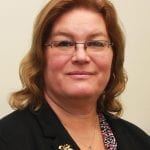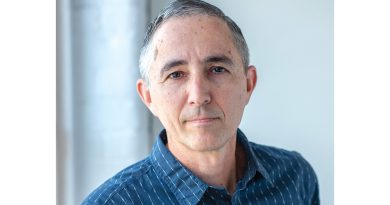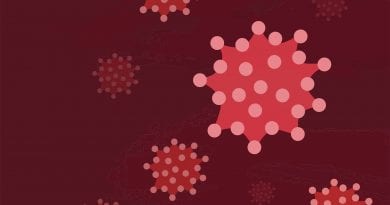College Healthcare Programs Meet Unprecedented Challenge
Hands-on Learning in a Hands-off World
By Mark Morris
A pandemic has a way of forcing people to be flexible and creative.
That’s especially true for colleges that prepare students for futures in nursing, physical therapy, and other healthcare occupations. Instructors have transitioned in-person lectures to online learning without much fuss, but health programs also require students to spend months in a clinical setting to obtain hands-on experience. Without this real-world knowledge, students cannot graduate or receive the proper accreditation to become professionals in their field.
Amy Brandt, dean of Health Sciences at Holyoke Community College (HCC), was working in New York when the outbreak kicked into high gear last March. Clinical sites she worked with were concerned about student safety and a less effective learning environment at a time when everyone was trying to find their way.
“They knew it wasn’t business as usual,” she said.
Normally, hospitals, long-term-care centers, and other facilities maintain a consistent flow of students coming in for what are known as clinical rotations. This hands-on training is valuable to colleges, their students, and the healthcare organizations themselves, which face a constant need for trained staff. Clinical rotations enable these facilities to educate the workforce they will need going forward.
When COVID-19 came ashore in the U.S. and quickly spread, hospitals and medical practices faced the overwhelming task of managing high numbers of infected patients while keeping their staff and other patients safe. Not surprisingly, clinical rotations were put on hold.
The lack of clinical access was most noticeable with nursing programs, but Karen Rousseau, dean of the School of Health Sciences at American International College (AIC), said it had an impact on other health programs as well.

“We are going to see more telehealth in health care, so education needs to address this on a broader scope going forward.”
“Physical-therapy and occupational-therapy clinics actually closed and weren’t providing care for quite some time,” she said. “We had to delay student placements until these clinics reopened and rebuilt their patient volume.”
Over time, said Lisa Fugiel, assistant dean and director of Nursing at Springfield Technical Community College (STCC), hospitals and other clinical partners have been able to gradually increase access to their facilities.
“We appreciate our practice partners finding creative ways to work with us to continue offering clinical experiences, because we can’t graduate our students without them.”

“We appreciate our practice partners finding creative ways to work with us to continue offering clinical experiences, because we can’t graduate our students without them.”
For this issue’s focus on healthcare education, faculty from area colleges spoke with HCN about how they are overcoming the challenges of preparing tomorrow’s healthcare workforce during a pandemic that still hasn’t faded.
Access Points
Classroom labs are another required part of healthcare curriculum requiring in-person learning. So, on top of clinical access, colleges had to also figure out a safe and effective way to bring students back to campus for those labs.
Christopher Scott, dean of the School of Health at STCC, was part of a ‘repopulation committee’ on campus that recommended limiting the number of students per lab and providing N95 masks for everyone. The nature of classroom labs requires close contact, so there was concern that standard masks would not effectively protect students from classmates who might have been exposed. Finding solutions has been an education for everyone involved.
“Our first-year students had to learn how to breathe from extended mask wearing,” Scott said, pointing out how that was not the norm prior to COVID-19.
Fugiel added that the necessity of wearing gloves, goggles, and gowns means students need to better manage their time in the lab. “When they come in, they have several extra steps to take beyond just walking into the building and the classroom.”
For safety reasons, clinical rotations consist of smaller groups of students for shorter durations. STCC has set up a system where a group of students works in a clinical setting for one week, and then switches to learning with virtual simulation models the following week.
The various regulating bodies that work with the colleges have weighed in on what’s acceptable for clinical rotations during these unique times. Depending on the program, Fugiel said the accreditation boards have provided guidance that allows students to split their time among hands-on care, virtual simulation, and classroom labs in order to meet their standards.
“By doing this, our students will receive constant education and can meet the requirements of the program,” she noted. “Also, we have to keep in mind that, at any time, COVID cases could increase, and we would be shut down again.”
Before COVID, Fugiel and her staff had begun to look into virtual simulation programs for nursing instruction. Once clinical access became more difficult, they quickly added these programs to the curriculum. Virtual simulation is a type of interactive software by which one or more students can work with a virtual patient from initial check-in through delivering a diagnosis.
Accepted in some areas of accreditation, Fugiel believes virtual simulation is an effective instructional tool because it encourages critical thinking and clinical reasoning. “The student can interact with the patient, and the instructor can check in to see how things are going, just like they would in an actual hospital setting.”
In addition to using visual simulations, Kayla Aliengena, chair of the Nursing program at HCC, said she wants to broaden the scope of simulations and hopes to incorporate virtual reality as a tool.
“We’re looking for alternate learning experiences that are more than just sitting at a computer,” she explained. “With virtual-reality-type programs, students can get closer to a hands-on experience.”
Some students have been involved in clinical experiences using telehealth. Rousseau said faculty who have run telehealth clinics have been able to help students maintain their clinical hours and keep them moving forward.

“This has been an interesting adjustment, and I predict this will be incorporated in more curriculums,” she noted. “We are going to see more telehealth in health care, so education needs to address this on a broader scope going forward.”
While these are all good alternatives, Aliengena made it clear that virtual learning does not replace actual experience.
“For a nursing student, ‘clinicals’ are the most exciting time in the course,” she said. “Everyone takes tests and attends lectures, but clinical work is where you get real hands-on experience in how to deal with people.”
Clinical partners also understand the importance of staying flexible and finding creative solutions. Aliengena noted that nursing students are able to stay on schedule because one local hospital has allowed students to access its maternity ward, which helps nursing students satisfy their curriculum demands.
Seeking clinical experience in more than one setting is an approach Fugiel said is working at STCC.
“We are encouraging different settings like vaccine clinics, or, if they are in acute care, we’ll rotate them through long-term care,” she explained, noting that, while settings may vary, the requirements to graduate do not.
“We evaluate the clinical work of our students the way we always have,” Aliengena added. “They are expected to meet the same standards and capacity as if a pandemic wasn’t occurring.”
Pressing Pause
Because standards cannot be compromised, some students have opted out of programs for now.
“Going to nursing school is hard all by itself — now let’s add a pandemic,” Fugiel said. “Many of our students work in healthcare, so they’re trying to meet the demands of work, the needs of the community, and then go to nursing school. On top of that, many have families and are trying to manage schooling for their kids. All together, it just becomes too much.”
When students expressed anxiety about clinical rotations during the pandemic, Rousseau reminded them how clinical placements are a choice the individual makes in order to progress. One option is to delay graduation until they can complete their clinical practice hours. But, after conversations with reluctant students, Rousseau said many end up pursuing their clinical placement.
“We are all healthcare providers, so we learn how to protect our patients and ourselves, even when we are confronting a communicable disease,” she added.
Still, there’s nothing like a pandemic to suddenly make book learning more relevant. Rousseau said community-health course topics on infection control and the pandemic from 100 years ago took on new significance with students.
“Of course, we talked about how we’re living through a pandemic right now,” she noted. “All these topics that we used to look at from a historical perspective really apply today.”
The next historic step in fighting the coronavirus involves vaccinating millions of Americans. Local students have begun playing a role in this important effort. Fugiel said STCC is getting involved with several community locations, as well as its practice partners.
“We’ve suggested having students give the vaccine to each other,” she said. “This way, they can practice giving the shot and can help the clinical facility give vaccinations to their staff, so everyone wins.”
Nursing students from AIC were involved with contact tracing earlier to help local public-health organizations. Rousseau sees mass vaccinations as an opportunity for public-health students to make a similar contribution.
“There is a processing piece that has to occur with the vaccination,” she said. “Our public-health students may be able to help with that piece and allow them to be part of the solution.”
Since the outbreak of COVID-19, Rousseau said, the general population looks at public-health leaders differently. “Look at how people hang on every word when someone like Dr. Anthony Fauci speaks. I think this could lead to increased enrollments in public-health areas.”
While the long-term effects of COVID-19 are still unknown, some early findings suggest many people will need treatment in a home-care setting. According to Brandt, this could mean a boost in allied healthcare jobs such as dieticians, occupational therapists, and others.
“There are solid opportunities for people who are not ready to take on the rigorous demands of nursing school,” Brandt said. “We are seeing people choose shorter-term certificate programs like medical assistant or phlebotomy, which are good jobs that are also needed.”
Opportunity Knocks
Despite the added stress and disruption, Aliengena believes the pandemic has opened a gateway of unique opportunities for both students and faculty.
“Students who might have been hesitant to take an online course or a blended platform course were kind of thrown into the opportunity,” she said. “It also opened minds for faculty members regarding online learning and how to use different technologies to provide new types of clinical experiences.”
While the stress level has eased somewhat as clinical access has improved, Brandt added, “we are still dealing with unprecedented times.”




